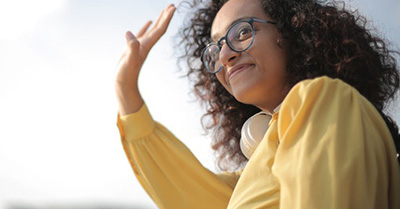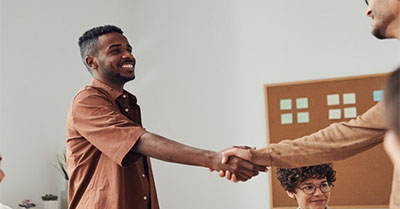Email this page
One of the first things you learn in a new language is how to greet someone. In English, you learn to say “hello” or “hi.”
Besides “hello” and “hi,” there are many other ways of greeting someone. Let’s look at some of them in this lesson.

Andrea Piacquadio | Pexels
Formal Greetings
Depending on the time of day:
- Good morning!
- Good afternoon!
- Good evening!
When leaving, you say...
Other formal greetings
- Hello!
- Nice to meet you.
- Good to see you.
You can say “Hello” and add this, too
- How are you?
- How are you today?
- How are you doing?
- How are things?
Note. People say “How are you?” or “How are things?” as a greeting. They are not really questions that you must answer. Sometimes people just say hello back.
Look at this example dialog:
— Hello, John! How are you doing today?
— Good morning, Kate! Good to see you.
And that’ it. John did not expect Kate to answer “how are you doing” because it was not really a question.
But it is okay to answer it, too. For example,
— Good morning, Susan! How are you doing today?
— Good, thanks! It's nice to see you, David.
Combining Greetings and Being (Very) Formal
You can combine many of the above formal greetings and sound very formal.
Examples
- Good morning, sir. How are you?
- Good afternoon, ma’am. How are you today?
- Hello, Mr. Smith! It’s good to see you again. How are you doing this morning?
Informal Greetings
You can use the following greetings with family, friends, or people you have a casual, friendly relationship with.
Examples
- Hi!
- Hey!
- What’s up? or Sup? (very informal))
- What’s new?
- What’s going on?
- What’s happening?
- Yo! What’s up (very informal)
When you have not seen someone for a long time, you can say
When you have not seen someone in a long time or you are surprised to see someone, you can say
- Well, hello!
- Look who it is!
Combining Greetings and Being (Very) Informal and Friendly
You can combine many of the above informal greetings and sound very informal and friendly.
Examples
- Hey, [name]! How’s it going?
- Hi there! What’s up?
- Hi there! What’s going on?
To show surprise or when you have not seen someone for some time, you can say
- Hey! Look who it is! How’s it going,[name]?
- [Name]! Long time no see! What’s up?
Meeting or Seeing Someone Again
You can say just “Hello” after meeting a person and seeing them again another day. However, it is common to add some extra information. Saying the person’s name is always a good idea.
You can say the following:

Fauxels | Pexels
You can say “Hello, [name]!” and add...
- It’s nice to see you!
- It’s nice to see you again.
- It’s great to see you.
- It’s great to see you again.
- Great to see you (again).
- Good to see you (again).
Note. If it is the first time meeting a person, you say, “Good to meet you” (or other greetings), not the greetings above.
Cultural Notes on Formality
Formality Levels in the United States
In American culture, people tend to be more relaxed about levels of formality. Depending on where you work, you may greet your colleagues and superiors informally.
When you go shopping, store clerks tend to be friendly, so they may use casual greetings. However, they are still polite in other ways. For example, they may say “Hi, sir!” or “Hi, ma’am!” Using both “hi” and “sir” or “ma’am” makes the greeting both casual and still polite and respectful.
What if You are Unsure about the Situation?
In a new situation, pay attention to how people greet you so you know what level of formality is appropriate.
Using a Person’s Name
In American culture (as in many other cultures), it is important to use people’s names in a greeting or during a conversation. If you see someone again and forget his or her name, it is okay to say you are sorry for forgetting and to ask the person to repeat it.
During a conversation, you should say the person’s name. You do not have to say it all the time but sometimes.
Using people’s names makes themn feel respected. It also shows them that you are interested in them (at least interested enough to remember their names).
If you are unsure about the level of formality to use, it is better to be formal and polite than to be too casual and friendly in the wrong situation.